Digmesa develops simple, reliable and cost-efficient remote filter monitoring system with LoRaWAN
Problem
Ion exchange-based water softeners often employ filter cartridges whose resin binds the undesirable calcium ions. These cartridges have to be replaced after passing a certain volume of liquid. This flow volume is dependent on the hardness of the untreated water and the desired hardness of the filtered water. As a general rule, larger cartridge-based water softeners keep a running total of the flow volume and trigger an alarm on reaching the maximum capacity, signalling the need for a manual filter change. In this case, the alarm is visible on a display or LED; an audible alarm may also be employed. The problem here is that the alarm is not passed on, that is to say it is only visible or audible in the immediate vicinity of the filter. This means that the operator would have to be in close proximity to the water filter to become aware of the alarm, in effect to be standing next to the water filter, then change the cartridge and reset the flow sensor.
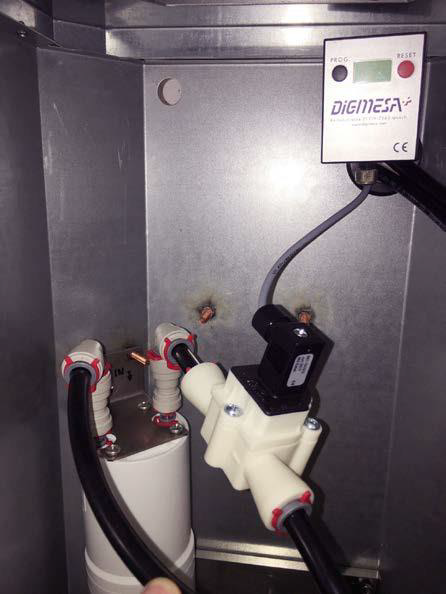
Photo by Digmesa AG
Current problem-solving approaches
Remote filter monitoring is thus often called for wherever the quality of the filtered water is of the utmost importance and should not be subject to fluctuation, for example, in the catering area. Although buzzwords such as “Cloud”, “IoT” and “Internet” convey the impression that this should be easy, a remote filter monitoring system has only rarely been realised to date. This paradox can be understood if you consider the implications of failing to replace a cartridge: if the maximum flow volume is exceeded, the filtered water gradually becomes harder without in any way being hazardous to health, at most detracting from the quality of the subsequent processes. In addition, it should become apparent to the filter operator over time that the filtered water no longer conforms to the customary standard. The irritation of a cartridge replacement alarm is therefore relatively small. This also explains the scarcity of investment in alarm systems by filter operators at the present time. A second reason lies in the methods for remote reading and remote alarm triggering commonly employed up to now. They include, for example, alarm initiation via
• an RTU module with 3GSM connection,
• a WLAN gateway and a central app server,
• a mobile app, connected to the flow sensor module via Bluetooth.
Current solution approaches unsatisfactory
The above-mentioned processes are unsatisfactory because the implementation costs are too high (GSM connection), because the simple app solution via Bluetooth can only be implemented at distances of up to a few metres (that is to say over a short range) and because the WLAN gateway access is insecure. The approach which is based on the shared use of (WLAN) gateways frequently presents operators of remote monitoring with a dilemma in practical operation. Data transmission via a shared WLAN gateway cannot be guaranteed; a dedicated WLAN gateway for the filter monitoring means high additional costs. Conclusion: a simple and reliable solution for reasonably priced remote filter monitoring is not yet available!
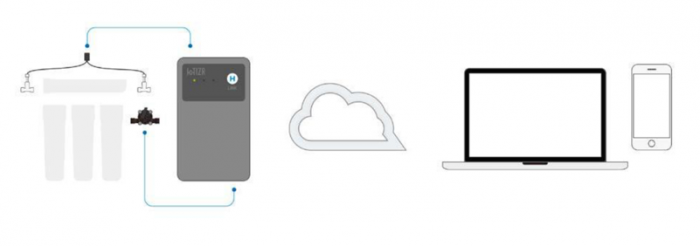
Photo by Aplix.co.jp
Digmesa pilot project with LoRaWAN
Long Range Wide Area Network (LoRaWAN) is a low-power wireless network protocol. The LoRaWAN specification is set by the LoRa Alliance. It is freely available and utilises Semtech Corporation’s proprietary “LoRa” chirp spread spectrum modulation technique.
LoRaWAN is a wireless technology for data transmission in the Internet of things. Accepted worldwide, this technology transports low data throughputs from sensors, actuators, counters and data from measuring instruments cost-effectively even in situations where networking using conventional mobile radio technologies is not possible. LoRaWAN stands out for its extremely high energy efficiency, long range and also for its very high security standards. The LoRa modulation technique is asymmetrically geared towards the energy efficiency of IoT devices and offers long ranges for the uplink communication, that is to say the transmission from the IoT device to the network.
The ranges extend from 2 km (urban area) or 15 km (suburbs) up to 40 km (rural areas). Another advantage is the penetration of buildings, enabling a degree of service to be provided to underground premises. The current consumption of end devices is around 10 mA and 100 nA in sleep mode. Depending on the application and disregarding self-discharge, this facilitates a battery life of 2 to 15 years. Communication between the end devices and the gateways takes place via different frequency channels with different data rates. These lie between 0.3 kbit/s and 50 kbit/s.
Trends in favour of remote filter monitoring:
• Public LoRaWAN networks are spreading rapidly all over the world
The Netherlands, Switzerland and South Korea are among the first countries with nationwide LoRaWAN coverage. In Germany, the Sigfox coverage is expected to be around 85% by the end of 2018. Internationally, Sigfox is represented in 45 countries and is set to expand to 60 countries by 2018. In Russia, 30 million people have access to a LoRaWAN network and France also has good coverage. (Source: Wikipedia)
• The LoRa Alliance appears well-placed to establish the specification worldwide
To date, it has been established in 100 countries and more than 500 communities. Around 7,500 LoRaWAN gateways are already active there. The leading locations are Zurich, Bern, Amsterdam and Berlin. In Germany, over 600 gateways have been installed in more than 62 towns and other places. The leading city in Germany with the largest number of installations is Berlin. 75 IoT/TTN gateways have already been installed there in 17 months and integrated to form a city-wide, fully usable network. It can be used free of charge and requires no advance authorisation. (Source: Wikipedia/www.lora-alliance.org)
• In many countries, service providers help to supplement the LoRaWAN infrastructure (e.g. app server capacity leasing)
These service providers are often identical to the LoRaWAN network operators (Swisscom, for example).
• Prices of LoRa chip sets are steadily falling
LoRa wireless interfaces for sensors will be inexpensive for sensor manufacturers to integrate into the sensors and are already available for less than 2 $.
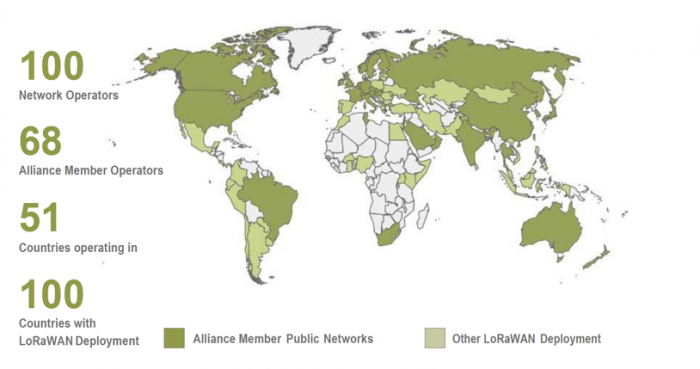
Photo by www.lora-alliance.org
• hftm Biel thesis
Digmesa has lent its support to a thesis at the hftm Biel involving the evaluation of flow rate data via an Arduino module, LoRaWAN, app server and mobile app / GUI.
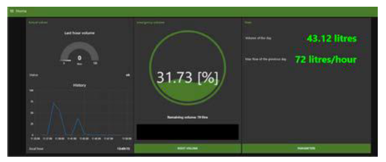
Photo by Digmesa AG
Filter capacity alarm and measurement data depiction on the GUI, the graphical user interface, can be quickly realised. The coding/programming of the graphical user interface can be outsourced to an external developer.
The pilot project has confirmed the feasibility of data transmission even at an antenna distance of 8 km. However, an external antenna had to be employed in order to achieve the requisite signal- noise ratio. Thus the availability of a dense public LoRaWAN network for use in filter cartridge monitoring becomes an important decision-making criterion. The tendency for filter cartridges to be located in cellars or at the rear of ground floor premises adds to the range problem. The use of external antennae drives up the cost per measuring point.
It is still not possible at the end of 2018 to answer, with the required degree of certainty, the question as to whether LoRaWAN will be able to achieve the necessary coverage in urban agglomerations but the prospects are positive [see “Trends in favour of remote filter monitoring”].
Remote filter monitoring costs per measuring point and year markedly lower with LoRaWAN
The total cost per remotely monitored measuring point (in this context: per cartridge) is the key parameter of every remote monitoring project.
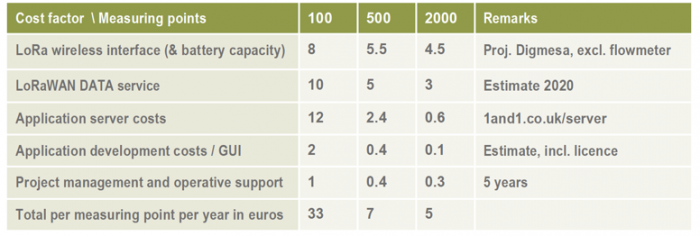
The pilot project was used to estimate the annual remote filter monitoring costs (the amortisation period used for the purchased hardware and software is 5 years). This estimate contains only the remote monitoring; the flow sensor (ca. 10 to 15 euros, one-off) must be added in each case.
The cost trend in the subsequent years is stable or slightly falling.
The initial estimate of costs indicates that remote monitoring is today realisable with markedly reduced full costs, compared with earlier wireless solutions and dedicated (APP) server. Should external antennae be required, the costs per measuring point and year rise by 10 to 15 euros.
Conclusion
Data transmission continues to be the critical element in current remote filter monitoring projects. Here, decisions must be made based on the local availability of public IoT data networks. The fact that the LoRaWAN network represents the world’s fastest-growing technology alliance is a positive factor.
Provided the infrastructure and IT services and, above all, a dense LoRaWAN are available, data transmission, data preparation and the GUI, that is to say all important service elements, can be outsourced to third-party providers. Here the “total costs per remotely monitored measuring point” are markedly lower than those for conventionally designed solutions. Competent overall project management remains an indispensable requirement.
For more information, please visit http://www.digmesa.com.
News Categories
- » NEWS HOME
- » Automation & Robotics
- » Industry 4.0
- » Material Handling
- » Sensors
- » Quality & Testing
- » Machine Vision
- » Laser & Optics
- » Metalworking
- » Motion Control & Drives
- » Hydraulics & Pneumatics
- » Process Industry
- » Renewable Energy
- » Agriculture
- » Home & Office Furniture
- » Environmental Tech









